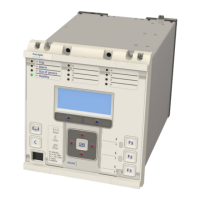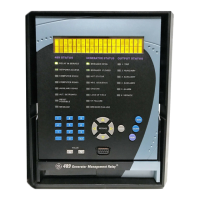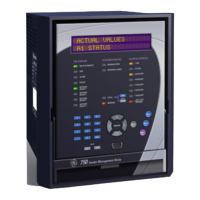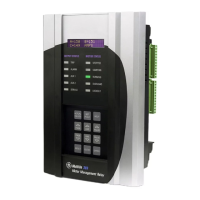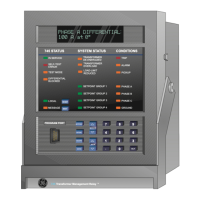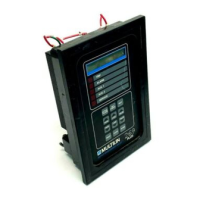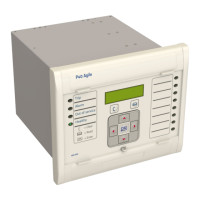
Do you have a question about the GE MiCOM P40 and is the answer not in the manual?
| Voltage Inputs | 3-phase voltage inputs |
|---|---|
| Current Inputs | 3-phase current inputs |
| Frequency | 50/60 Hz |
| Type | Numerical Relay |
| Current Rating | 1A / 5A |
| Protocols | IEC 61850, DNP3, Modbus |
| Protection Functions | Overcurrent, earth fault, frequency protection |
| Communication Interfaces | Ethernet |
| Power Supply | DC or AC supply options |
| Mounting | Rack Mount |
Provides general information about the technical manual and an introduction to the device(s) described.
Provides a functional and technical description of the device and instructions for its use.
Describes the product's scope, including its capabilities and applications.
Details the various protection, control, measurement, and communication functions of the device.
Explains the convention for elements used in logic diagrams, including symbols, colours, and shapes.
Provides a diagram illustrating the device's functional overview applicable to multiple products.
Provides information about the safe handling of the equipment and keeping personnel safe.
Details essential safety information for personnel working with electrical equipment.
Explains the various symbols used throughout the manual and on the equipment.
Covers hazards and precautions related to installation, commissioning, and servicing.
Provides guidance on the safe decommissioning and disposal of the equipment.
Details the product's compliance with various European Commission Directives and standards.
Provides information about the product's hardware design.
Describes the main components comprising the General Electric Sampled Values device.
Details the modular hardware architecture, case sizes, and housing variants.
Describes the components and layout of the 40TE front panel.
Describes the rear panel construction, including cut-outs and slot allocations.
Details the selection of PCBs (Printed Circuit Boards) and subassemblies.
Describes the software design of the IED.
Categorizes the device software into system level, platform, and protection/control software.
Covers the real-time operating system, system services, and self-diagnostic software.
Details the three main functions: record logging, settings database, and interfaces.
Describes the processing of protection elements and measurement functions.
Describes the common methodology for setting parameters across the product series.
Explains the use of MiCOM S1 Agile software for device configuration and management.
Provides instructions on navigating menus, displaying status, measurements, and fault records.
Details the circuit information required for distance protection, including impedance and phase rotation.
Explains how to set the date and time, including SNTP, IRIG-B, and PTP synchronization.
Describes how to select setting groups using opto-inputs, menu selection, or hotkeys.
Describes the operation of protection functions using Power swing Analysis.
Defines Process Bus communications and the use of sampled value data from Merging Units.
Explains how the SV interface receives and resamples data for IED analogue inputs.
Describes how to set the merging unit delay to manage transmission delays of Sampled Value frames.
Introduces the principles and theory behind distance protection and its implementation.
Provides an overview of distance protection principles and components.
Explains the principles behind constructing measuring zone characteristics like Mho and Quadrilateral.
Details the implementation of phase and earth fault distance protection, including settings and logic.
Describes the Delta algorithm for directionalizing distance elements and its use in aided schemes.
Provides guidance on setting modes, operating characteristics, and zone reach settings.
Introduces unit schemes and general-purpose teleprotection signalling using fibre-optic communication.
Explains the provision of communication channels for unit protection schemes.
Details the use of tripping schemes to connect devices and provide fast clearance.
Describes Permissive Underreach and Permissive Over-reach schemes.
Explains the use of Directional Earth Fault (DEF) elements with communication schemes.
Describes how Delta directional comparison protection is implemented.
Provides recommendations for PUR, POR, Blocking, and Delta schemes.
Describes distance schemes that do not require communication between ends.
Covers standalone non-unit protection and special standalone schemes.
Explains the basic scheme operation, modes, and settings.
Details logic for special tripping following circuit breaker closure (SOTF and TOR).
Describes application of Zone 1 extension for high-speed protection on radial overhead lines.
Provides fast unit protection for faults on double end fed lines without communications.
Describes special blocking and protection functions using Power swing Analysis.
Explains power swings, their causes, classification, and impact on distance protection.
Details power swing detection techniques and configuration.
Describes Out-of-Step detection based on impedance measurements and uses of quadrilateral characteristics.
Describes the operation, principles, logic diagrams, and applications of Autoreclose functionality.
Explains the transient nature of faults and the role of autoreclosing.
Defines terminology and describes the product's multiple-shot autoreclose function.
Describes the system design of the Autoreclose Logic and logic module interconnections.
Details logic inputs, outputs, operating sequence, and high-level system design.
Provides guidance on setting de-ionising time, dead time, and reclaim time.
Describes the operation of Circuit Breaker Fail Protection, including principles and applications.
Explains the importance of CBF for fault isolation and system stability.
Details the implementation of CBF using timers and zero crossing detection.
Provides logic diagrams for CBF operation, including parts 1-4.
Offers guidance on reset mechanisms and setting guidelines for CB Fail timers.
Provides an overview of current protection functions, used as backup protection.
Details phase fault overcurrent protection, including POC implementation and directional elements.
Explains negative sequence overcurrent protection and its implementation.
Describes earth fault protection, including measurement and directional elements.
Details sensitive earth fault protection and its EPATR B curve.
Explains the principle and connection of high impedance restricted earth fault protection.
Describes thermal overload protection with single and dual time constant characteristics.
Explains broken conductor protection and its implementation.
Describes the device's wide range of voltage protection functions.
Details undervoltage conditions and implementation.
Describes overvoltage conditions and implementation.
Explains the compensated overvoltage function and its parameters.
Describes residual overvoltage protection and its implementation.
Describes frequency protection functions, including principles, logic diagrams, and applications.
Details underfrequency and overfrequency protection and their implementation.
Explains independent rate of change of frequency protection.
Provides an overview of protection functions, monitoring, and control functionality.
Explains how the IED records events for situation analysis.
Describes the disturbance recorder feature for recording inputs and extracting data.
Details measured quantities, setup, fault locator, and opto-input time stamping.
Describes the device's monitoring of circuit breaker trip operations.
Explains the monitoring of circuit breaker open or closed states using auxiliary contacts.
Details control of circuit breakers using IED menu, hotkeys, function keys, opto-inputs, or SCADA.
Describes the Pole Dead Logic used to indicate unenergised phases.
Covers Live/Dead Voltage Monitoring, Check Synchronisation, and System Split indication.
Introduces PSL Editor, configuration of digital inputs/outputs, and scheme logic concepts.
Explains the flexible configuration of digital inputs and outputs using settings and PSL.
Describes Fixed and Programmable Scheme Logic (FSL and PSL) and their interaction with the IED.
Details the configuration of optically isolated status inputs (opto-inputs).
Explains how relay contact action is controlled using PSL and relay output conditioners.
Describes the four fixed-function LEDs on the front panel and their indications.
Explains the three types of programmable LED signals and their illumination control.
Details the use of programmable function keys for controlling functionality via PSL.
Describes control inputs as software switches for setting or resetting locally or remotely.
Provides information about fibre-optic communication for unit schemes and teleprotection.
Explains the need for communication channels for protection signalling and teleprotection.
Details the Fibre Teleprotection interface and setting up IM64 schemes.
Describes the logic diagrams for IM64 channel fail, scheme fail, and general alarm signals.
Provides notes on alarm management and alarm logic for IM64 communications.
Describes the operation of electrical teleprotection functions.
Explains the use of communication links for protection schemes and teleprotection.
Details direct tripping, permissive tripping, and blocking schemes.
Describes the configuration of Electrical InterMiCOM using settings and PSL.
Explains how to customize command signals for security, speed, and dependability.
Provides instructions for connecting to Electrical InterMiCOM using short distance and long distance.
Offers guidance on effective communications for teleprotection schemes.
Discusses the need for cyber-security in substation environments due to evolving technology and threats.
Explains cyber-security requirements like confidentiality, integrity, availability, and non-repudiation.
Lists applicable standards for substation cyber-security, including NERC CIP and IEEE 1686.
Describes current cyber-security measures at IED and external levels.
Provides information about installing the product.
Discusses requirements for receiving, unpacking, storing, and dismantling the product.
Details mounting procedures for flush panel and rack mounting.
Describes the types of wiring and connections for device installation.
Provides case dimensions for different models, including 40TE.
Contains sections on general guidelines, test menus, equipment, and product checks.
Provides general guidelines for commissioning IEDs, emphasizing verification of hardware and software settings.
Describes test facilities for monitoring opto-inputs, relay outputs, DDB signals, and LEDs.
Lists recommended, essential, and advisory test equipment for commissioning.
Details checks for device physical damage, functionality, and measurement accuracy.
Explains how to configure and perform loopback tests for InterMiCOM communication.
Details the use of InterMiCOM 64 for fibre teleprotection and setting up the loopback.
Ensures application-specific settings are correctly applied, with options for file transfer or manual entry.
Describes test modes for IEC 61850 Edition 2, including IED and Sampled Value test modes.
Details testing procedures for distance protection, including single-ended and scheme tests.
Explains testing procedures for delta directional comparison schemes.
Covers testing procedures for Earth Current Pilot, Permissive, and Blocking schemes.
Describes testing procedures for Out of Step detection, including OST and Predictive OST settings.
Verifies the timing of overcurrent and earth fault protection functions.
Covers system voltage checks and check synchronisation functions.
Describes testing of the auto-reclose function for trip and close operations.
Checks signalling channel ability to transmit ON/OFF signals used in aided schemes.
Confirms scheme readiness for full operation when telecommunication channels are available.
Details checks performed when the plant is energized.
Ensures all settings and hardware are correctly applied and the IED is restored to service.
Describes the commissioning procedure for P59x devices.
Details how to maintain and troubleshoot products based on Px4x and P40Agile platforms.
Provides guidance on regular checks, opto-isolators, output relays, and measurement accuracy.
Helps identify error conditions on the IED and suggests appropriate corrective actions.
Describes the technical specifications of the product.
Details the standard and optional hardware and protocols.
Lists protection functions including distance, power swing, and autoreclose.
Covers event records, disturbance recorder, measurements, and CB condition monitoring.
Details measured quantities, disturbance records, and event logs.
Provides ratings for AC measuring inputs, current, and voltage transformers, and auxiliary supply.
Describes isolated digital inputs and standard output contacts.
Details physical parameters, enclosure protection, mechanical robustness, and transit packaging.
Covers insulation, creepage distances, dielectric withstand, and impulse voltage tests.
Specifies ambient temperature range, temperature endurance, humidity range, and corrosive environments.
Details tests for high frequency disturbance, oscillatory waves, electrostatic discharge, and surge withstand.
Lists compliance with European Directives (EMC, LVD, R&TTE) and UL/CUL, ATEX standards.
Provides a detailed list of product variants, hardware options, and protocol options for ordering.
Details system settings, including language, password, and general configuration.
Covers settings for distance protection, including phase and ground elements, and characteristic settings.
Details settings for power swing blocking and out of step protection.
Lists autoreclose modes, CB status inputs, logic diagrams, and related settings.
Provides external connection diagrams for COMMS options, including serial ports and Ethernet.
